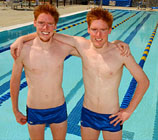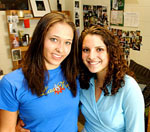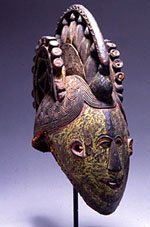|
Précis
| Autumn 2003
 Women
and the arts: In
a renovated Masonic temple just a few blocks from the White
House, Judy L. Larson ’98PhD presides over the only museum
in the country dedicated solely to art by women.
The
National Museum of Women in the Arts–with a permanent collection
containing works by eight hundred female artists dating from
the sixteenth century to the present–is so surprising in
scope that visitors who intend to take a quick tour between
the Smithsonian and the Mall end up spending the whole afternoon
wandering its galleries. Women
and the arts: In
a renovated Masonic temple just a few blocks from the White
House, Judy L. Larson ’98PhD presides over the only museum
in the country dedicated solely to art by women.
The
National Museum of Women in the Arts–with a permanent collection
containing works by eight hundred female artists dating from
the sixteenth century to the present–is so surprising in
scope that visitors who intend to take a quick tour between
the Smithsonian and the Mall end up spending the whole afternoon
wandering its galleries.
Remembering
war: A distinct, close-knit group of World War
II veterans who attended the Emory School of Law in the years
1947-1951 have maintained their special bond, gathering regularly
at dinners and social events. These men and their stories are
now the focus of the Emory Oral History Project: WWII Era, an
effort to preserve their experiences and memories for future
generations of Emory students.
Fighting
cancer: This summer, Emory’s Winship Cancer
Institute moved into a state-of-the-art, $75-million building
on Uppergate Drive behind Emory Clinic A. The first four levels
provide patient care and services; the top three floors are
dedicated to research.
 Welcome,
Class of 2007: After
eighteen years in the same house, at the same school, and on
the same swim team, Andrew and Thomas Roos, twins from Culver
City, California, didn’t necessarily plan to attend the
same college. It just so happens, however, that they both chose
Emory. The Roos brothers competed for a place at Emory with
a record number of applicants: 10,384 students vying for 4,316
acceptance letters. About 1,270 arrived on campus this fall. Welcome,
Class of 2007: After
eighteen years in the same house, at the same school, and on
the same swim team, Andrew and Thomas Roos, twins from Culver
City, California, didn’t necessarily plan to attend the
same college. It just so happens, however, that they both chose
Emory. The Roos brothers competed for a place at Emory with
a record number of applicants: 10,384 students vying for 4,316
acceptance letters. About 1,270 arrived on campus this fall.
Taking
it to the next level: For
the fifth-grade students of Jason Clark ’02C, a lunch at
the DUC was about more than just eating hamburgers and pizza.
Clark arranged for his entire class to spend a day at the University
last spring, and for an Emory student or faculty member to be
at each table during lunch.
 27
Questions: The
Internet isn’t just for dating services anymore. Freshman
roommates Kelly
Kristal and Sarah Sweeney
found one another through Emory’s Online Housing Selection
Process, a roommate-matching program developed by the company
WebRoomz that the University used for the first time this year.
Fewer than a dozen colleges offer such a program. 27
Questions: The
Internet isn’t just for dating services anymore. Freshman
roommates Kelly
Kristal and Sarah Sweeney
found one another through Emory’s Online Housing Selection
Process, a roommate-matching program developed by the company
WebRoomz that the University used for the first time this year.
Fewer than a dozen colleges offer such a program.
Carnegie
scholar:
Associate
professor of political science Carrie Rosefsky Wickham Wickham
has been named one of thirteen new Carnegie Scholars by the
Carnegie Corporation of New York, the first Emory scholar ever
selected for this prestigious honor. Carnegie Scholars receive
up to $100,000 over two years to pursue pathbreaking research
in their fields. Wickham has been studying Islamic movements
for more than fifteen years—long before four hijacked airplanes
thrust the subject to the forefront of national consciousness.
Transition:
Howard
O. “Woody” Hunter, who has served as interim provost
since July 1, 2001, stepped down from the University’s
chief academic position on September 1. “Emory
owes a real debt of gratitude to Woody for his service,”
President James W. Wagner said. Holli
Semetko,
an expert on the role and influence of media in elections, politics,
and public opinion, is Emory’s new vice provost and director
of the Halle Institute for Global Learning.
Building
awareness of brain injury: Woodrow
Leake ’66C had never worked with disabled people when he
moved back to Atlanta to become president of the Brain Injury
Association of Georgia in 2001. Now facts and statistics roll
off his tongue with ease. Brain injuries are among the most
overlooked and under-reported conditions in the nation, says
Leake, with eighty thousand Americans becoming permanently disabled
each year. There are 150,000 in Georgia living with brain injury,
a figure that jumps by three thousand annually. Brain injury
is the leading cause of death and disability among people aged
16 to 35.
 Invoking
the spirits: Female
masks from Nigeria, the Congo, Sierra Leone, and Liberia are
on display in the Michael C. Carlos Museum’s third floor
Sutker Galleries, a renovated space that will be devoted to
displaying items from the museum’s permanent collection
of West and Central African art. The
masks portray a wide representation of female beauty and spirituality–decorative
scars, elongated necks, condensed features. As in Elizabethan
plays or Greek dramas, many were worn by male dancers impersonating
women. Invoking
the spirits: Female
masks from Nigeria, the Congo, Sierra Leone, and Liberia are
on display in the Michael C. Carlos Museum’s third floor
Sutker Galleries, a renovated space that will be devoted to
displaying items from the museum’s permanent collection
of West and Central African art. The
masks portray a wide representation of female beauty and spirituality–decorative
scars, elongated necks, condensed features. As in Elizabethan
plays or Greek dramas, many were worn by male dancers impersonating
women.
|